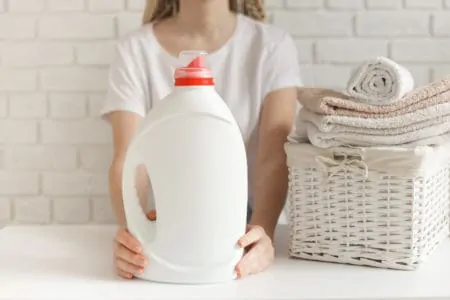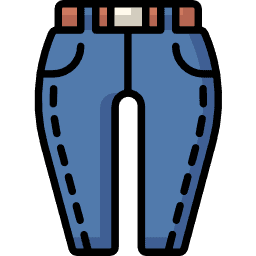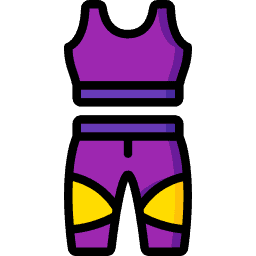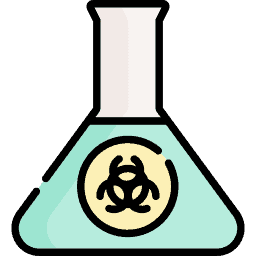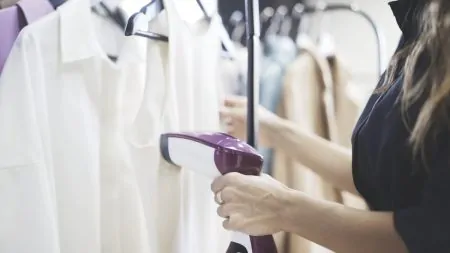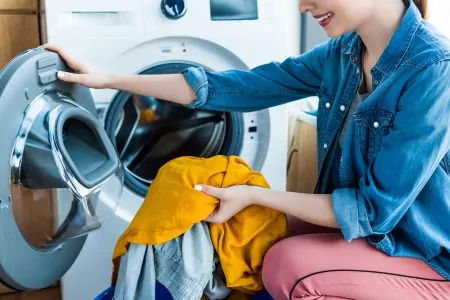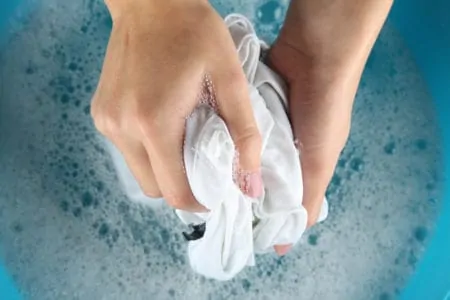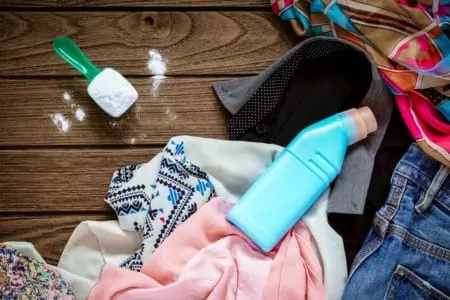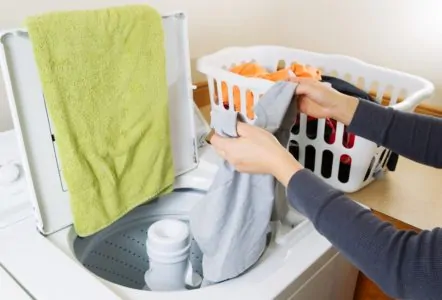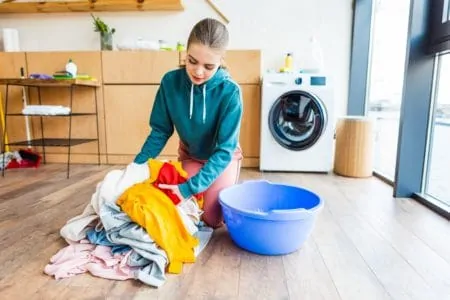The cozy cuddly pictures on the bottles of fabric softener have us all reaching for this product when shopping. Who doesn’t want soft, snuggly clothes at the end of laundry day?
But ask yourself: should I use fabric softener? In this article, we’ll discuss the pros and cons of using fabric softener, whether it’s necessary and some alternatives.
Key Takeaways
- Fabric softener isn’t necessary and can cause buildup on clothes, reducing absorbency and causing health issues from synthetic fragrances.
- Some eco-friendly alternatives include using baking soda, homemade dryer balls, or air drying clothes outside.
- Fabric softener may be useful for cotton, linen, and bedding, but should be avoided on flame-retardant fabrics, towels, clothes for sensitive skin, and sports gear.
- Liquid fabric softeners can be unsafe due to harmful ingredients and can clog washing machines, so consider alternatives like vinegar or homemade softeners.
What Does Fabric Softener Do?
If you’ve used fabric softener, you’ll be familiar with the main reasons why people love it. But there are some important cons of fabric softener to consider, too.
Pros
- It softens fabrics, so that you have comfortable clothes afterwards.
- It reduces wrinkles to speed up ironing.
- Fabric softener reduces static cling and prevents wear and tear during the washing cycle.
- Most fabric softeners are scented, so it adds a fragrant flair to your laundry load.
Cons
- It reduces the absorbing ability of certain materials, like towels.
- Fabric softener builds up on clothes over time and creates a barrier to soap and water. So if you find your clothes aren’t getting clean, it might be because of a film of fabric softener.
- If made with synthetic fragrances, it can cause headaches and respiratory problems (1).
Types of Fabric Softener
Although we’re focusing on liquid fabric softener, there are two other types: dryer sheets and dryer balls. These three types of fabric softener look very different but have similar roles on laundry day.
Liquid
Liquid fabric softener is great for removing odors and softening clothes. Liquid fabric softener is added during the rinse cycle and can reduce static and wrinkles.
It’s the most expensive of the three types, often made with chemicals that can irritate your skin.
Also — liquid softener builds up on clothes. This makes it a higher fire hazard than the other two types, according to the Consumers Union in the US (2).
Dryer Sheets
Dryer sheets are a cheaper alternative to liquid. They’re convenient and lightweight so you can easily take them to the laundromat or in your bag while travelling.
You can put dryer sheets into your tumble dryer with your wet clothes.
However, they have a filmy coating which can stain the inside of your dryer, clog the filter and leave more lint on your laundry.
Dryer Balls
Dryer balls are the cheapest option. They’re eco-friendly since you can reuse them. They are usually made with wool or heat-resistant BPA-free plastic.
While they still soften your clothes pretty well, you might find your laundry feels stiffer than it would with liquid fabric softener.
Dryer balls go into the tumble dryer with your wet clothes.
Is Fabric Softener Necessary?
Fabric softener is not necessary. Many people skip this step on laundry day. There are even materials which definitely won’t benefit from fabric softener. But some other garments certainly benefit from a bit of softening.
Which Fabrics Need Fabric Softeners?
- Cotton: Everyday clothes like cotton garments benefit from fabric softener. It can help to reduce static cling and make the clothes more comfortable.
- Linen: Fabric softener can help reduce static and wrinkles on linen. It also adds a nice scent and reduces drying time.
- Bedding: Adding fabric softener to your bed sheets can give them a lovely soft feel. It’ll make those eight hours of sleep even more relaxing.
When Not to Use Fabric Softener
- Flame-retardant fabrics: Check the label on your clothes as it might say whether or not the fabric is flame-retardant. It also might state not to use fabric softener. But this generally applies to children’s sleepwear, wool, silk, and synthetics.
- Towels: You might think that adding fabric softener will help your towel remain lush and fluffy. But in fact, the coating from fabric softeners reduces the absorbency of towels. If you do feel the need to use a softener, do it occasionally.
- Washing clothes for people with sensitive skin: This is especially important if using a non eco-friendly option. The fragrance and chemicals in liquid softeners and dryer sheets can irritate baby skin and people with skin allergies.
- Any sports gear: Sportswear is designed to absorb sweat. However, using a fabric softener can reduce the effectiveness of this purpose since it penetrates the clothes. Soon your sports bras, leggings and tops will lose their wicking abilities — not ideal for a morning at the gym.
- Whites: If washing whites, we recommend skipping the fabric softener. It can actually stain or yellow your whites.
Fabric Softener Alternatives
The moment we’ve all been waiting for: what are some alternatives to using fabric softeners? Thankfully, there are many amazing DIY and eco-friendly options to try.
Baking Soda
Baking soda does a great job of making water slicker and making it feel softer on your skin (3). Therefore, washing your clothes with a bit of baking soda can give you softer clothes.
This is a top tip if you live in a hard water area and constantly have stiff clothes after laundry day.
Add ½ cup of baking soda to your detergent dispenser. Or add directly into the washing machine drum before washing as normal.
Make Your Own Dryer Balls
Dryer balls are great for reducing static and softening clothes. While they won’t add extra fragrance, they are a good eco-friendly option. In fact, you can make your own!
- These instructions make six dryer balls. First, get 3 skeins of 100% wool yarn. The skeins should be about 210 yards and not washable. You’ll also need a large-eye needle.
- Wrap the wool around two fingers 10 times.
- Remove the yarn from your fingers. Wrap more yarn around the centre of the existing yarn 10 times.
- Wrap more wool around your yarn knot until you have a small ball. Don’t worry if it’s wonky looking!
- Continue until you have a wool wad the size of a tennis ball.
- Cut the wool and thread the needle with the tail, weaving it through a few threads on the ball.
- Stick it at an angle and pull it through the ball. Clip off the short strand of yarn that hangs out.
- To felt the balls, put them in a pair of tights and wash and dry three times.
- Now they are ready to be used! Toss all six into your drying cycles to help your clothes get soft and static free.
Distilled White Vinegar
Vinegar can soften fabrics and reduce static cling (4). While it has a harsh smell, we find that the smell doesn’t last through the washing cycle. But for an extra measure, add your favorite essential oil. We recommend a lovely mix of lemon and lavender.
Add ½ cup of vinegar to the fabric softener dispenser at the beginning of the cycle. Add about five drops of essential oils into the mix and wash the clothes as normal.
You can also spray the clothes with vinegar before they go into the dryer to help reduce static and stiffness.
Aluminum Foil Ball
This is a fun, easy and effective tip for reducing static and softening clothes.
Tear off a generous amount of tinfoil and crumple it into a baseball-sized ball. Throw it into the dryer. The tossing of the ball will agitate the clothes to break them apart, reducing static and adding softness.
Keep In Mind
A Tennis Ball
You might get a few funny looks at the laundromat with this tip. But when you take out your soft and static-free clothes, you’ll see why it’s worth it!
Adding a tennis ball to the drying cycle works similarly to the aluminum foil. It agitates the fabrics and keeps them apart which reduces static cling. It can also add some softness to your clothes. Use this on low heat cycles to protect the tennis ball.
Make a DIY Fabric Softener
If you love liquid softener but want an eco-friendly and cheaper alternative, you can make your own softener.
- Add two cups of epsom salt to a jar.
- Add ½ cup of baking soda to the jar.
- Add 40 drops of essential oils.
- Mix well.
- Add two or three tablespoons to the rinse cycle of your laundry load.
This recipe gives you soft, static-free and scented clothes.
Air Dry Your Clothes
The last tip we have is: air dry your clothes. Hanging them outside on a clothesline reduces static cling since the clothes are separated from one another.
You might find the clothes are a little stiffer than normal. But if you run them in the dryer for 10 minutes before hanging them up, this can help!
Bonus Benefit
Fabric Softener FAQs
Soft, Scented and Static-Free
These are the three things we all want from our laundry. Besides being clean, of course. You might have previously thought that liquid fabric softener or dryer sheets were the only way to achieve this. But now you know otherwise.
Use our alternatives to get soft and scented clothes that are static-free. It doesn’t require much effort at all, especially if you go for the tennis ball option.
If you’re still not sure you like these tips, keep in mind that fabric softener isn’t safe for you, your clothes, your machine or the environment.
